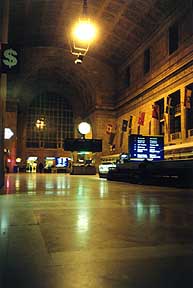
Union Station
A Tour of Canada's Greatest Train Station by Ninjalicious
Like many sheltered kids from the suburbs around Toronto, I was given my first taste of the big city's architecture at Union Station. When I first emerged into Union Station's cathedral-like Great Hall, I had to struggle very hard to keep the proper degree of teenage aloofness in front of my friends. In truth, I was absolutely blown away by the sweeping façades, the beautiful monumental architecture I later learned to call "Beaux-Arts", and the sheer size of the thing, which seemed to dwarf even Pickering's Sheridan Mall. It was the biggest, prettiest and oldest building I'd ever seen.
Construction began in 1913, but the station was not officially opened until 1927. The massive building, which occupies an entire block on Front Street between York and Bay Streets, has been the largest and busiest rail station in Canada since its construction. In recent years, Union Station has taken on added importance in the Metropolitan Toronto area as the terminal for commuter trains, bus, rapid transit and subway systems.
TTC Station
In Infiltration 5, I wrote about the rapid transit section of Union and the wonderful carved-rock tunnels that connect Union to Queens Quay. At the time I was exploring the station, both rapid transit stations were sealed off and the rail line had been replaced with a surface bus route. The TTC had announced that the rail line was being closed until March 1999 to allow crews to repair a leak in the tunnels between Union and Queens Quay, which lie entirely below lake level.
 That sounded pretty good to me. A floor-to-ceiling sliding aluminum gate had been stretched across the entrance to the rapid transit station, and a barrage of signs informed me that the station was closed and that I should use the bus instead. Failing to notice the signs (oops!), I slid open the unlocked gate and slipped through. A drywall barricade had been erected at the top of the stairs leading down to the RT. I pulled open an unlocked door in the makeshift wall and giddily skipped down the stairs. Several temporary offices had been thrown together out of particleboard at the base of the stairs. I didn't investigate these offices, as I could hear a man yelling at someone in one. At the end of the hall, I came to a newly installed glass door, pasted with a sign advising me that the area beyond was extra-specially off-limits.
That sounded pretty good to me. A floor-to-ceiling sliding aluminum gate had been stretched across the entrance to the rapid transit station, and a barrage of signs informed me that the station was closed and that I should use the bus instead. Failing to notice the signs (oops!), I slid open the unlocked gate and slipped through. A drywall barricade had been erected at the top of the stairs leading down to the RT. I pulled open an unlocked door in the makeshift wall and giddily skipped down the stairs. Several temporary offices had been thrown together out of particleboard at the base of the stairs. I didn't investigate these offices, as I could hear a man yelling at someone in one. At the end of the hall, I came to a newly installed glass door, pasted with a sign advising me that the area beyond was extra-specially off-limits.
When I pulled back the glass door, a thick cloud of dust and noise greeted me. No construction workers were in sight, but I could hear an orchestra of shrieking drills and pounding jackhammers at work nearby in the southbound tunnel. I quickly retreated to the northbound side. From within the tunnel, it became apparent that this leak repair business was no minor project. Aside from the makeshift offices I'd already seen, another cluster of offices had been erected in the maintenance area south of the station, and there was evidence of heavy construction vehicles having visited the tunnels.
I travelled down the tunnel very slowly. The ground was soaked with water from the leak; in some areas there were puddles I couldn't cross in my shoes. The air was nearly opaque with dust. I could see a pair of headlights shining in my direction somewhere further down the tunnel, but I couldn't hear any voices due to the roar of the machinery. I thought it would be really cool to walk all the way through the tunnels to Queens Quay and see what was going on down there. I suppose I pushed my luck a bit.
The employees spotted me before I spotted them, and turned off a machine or two so they could yell out to ask who I was. I stopped walking towards them. One of the workers (still quite invisible to me behind a brightly-lit cloud of dust) yelled to ask me what I was doing. At this point, I turned around and started slowly splashing my way back up the tunnel. Several more voices yelled out various things behind me, including "stop". At this point, I started marching back up the tunnels as fast as I could go without falling into any puddles. I made it back to the station in a couple of minutes and fully expected to be greeted by security, but either the workers in the tunnels weren't equipped with walkie-talkies or they decided to just dismiss me, for I was able to exit the rapid transit station without incident.
Train Concourses
Stairways at either end of Union's Great Hall lead down to the concourse level. From this level, one can access the GO and VIA concourses, the subway, the Royal York Hotel and the PATH walkway leading to the CN Tower, SkyDome and most of the major downtown malls and office buildings.
Though Union Station is owned by Canadian National Railways (CNR) and Canadian Pacific Railways (CPR), through their joint ownership of Toronto Terminal Railways (TTR), most of the station's real estate is devoted to Toronto Transit Commission (TTC) trains, Government of Ontario (GO) trains and VIA (doesn't stand for anything, but generally capitalized due to peer pressure) trains.
GO Transit didn't exist when Union Station was constructed, but since it was tentatively introduced to the station in 1967, GO's commuter train service has gradually become the primary function of Union Station. The half of the GO concourse adjacent to the tracks is a fare-paid zone, and the GO concourse is stocked with many surveillance cameras and bored GO security guards.
The VIA Concourse is a semi-fare-paid zone, only open to passengers and perhaps their well-wishers. Sometimes Union Station security guards stand at the entrance to the arrivals concourse to make sure everyone leaves and no one enters. Of course, the VIA area is quite large and well-connected to the rest of the station, so there are many routes around this blockade. I've found six. Once inside the VIA area, there are many doors, stairways and ramps leading to interesting semi-abandoned areas left over from the olden days when VIA service was much more extensive. You can also take ramps and stairs down into the parking garages or climb stairs up to the track level. If you are caught at track level without a ticket, you can claim that you're just into trainspotting. Rail fanatics are strange but real, and posing as one will make security consider you weird but not mischievous. A camera is obviously a good prop here.
The track level is accessible from either concourse. Union features a bunch of tracks which are usually filled with a bunch of trains. Most of the platforms are watched over by surveillance cameras, and crossing the tracks is definitely frowned upon.
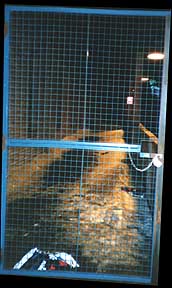 The main tourist attraction at the track level is the long-abandoned train shed at the easternmost end of track one. A ramp leading up to the old shed is blocked by a tall blue gate. When I visited the lock on the gate hadn't been fastened properly so I just slipped it off and wandered in, but even if the gate were properly locked it wouldn't take much effort to find a way around.
The main tourist attraction at the track level is the long-abandoned train shed at the easternmost end of track one. A ramp leading up to the old shed is blocked by a tall blue gate. When I visited the lock on the gate hadn't been fastened properly so I just slipped it off and wandered in, but even if the gate were properly locked it wouldn't take much effort to find a way around.
When I first entered the shed late one night I could hardly see anything. The roof has a few holes in it, but these were clogged with snow, and the windows were all caked with snow and dirt. There are no bulbs in any of the overhead lights, and probably no electricity anyhow. I didn't have a flashlight with me, so I explored very slowly until my eyes adjusted to the light. The shed is immense, containing two main tracks, on which are stored some very odd-looking railway vehicles. Weird old railway junk is everywhere; much of it was covered in snow when I visited. There are several huge freight elevator shafts set into the central platform, but peering into the shafts I saw that the elevators had been removed. The shafts offered a view a straight down to a dimly-lit, seriously flooded parking garage somewhere under the station.
Under the Station
Union Station is nice because it's so old and haphazard. I love seeing how the engineers have built around the original architecture, rather than simply demolishing it and starting fresh. It gives character. City planners could learn from this style of building. Among the best areas for spotting odd, out of place alcoves are the multiple levels under the station.
The parking garages can be accessed either through a set of automatic glass doors at the end of a hallway branching off from the VIA section (just past the security office), or through ramps leading down from VIA's arrivals concourse, or from the GO Concourse, through an unmarked brown door in the hallway leading to tracks 12 and 13. I'll refrain from writing too much about the parking garages, because I know that most people don't get all worked up over parking garages the way I do, but these really are beauties. Several fascinating old relics abound, including very oddly-shaped ancient elevators, many unlocked mechanical rooms and supply rooms, and all sorts of bizarre equipment I lack the vocabulary to describe. The walls, floors and high ceilings are alternately built out of red brick, cement, steel, asphalt and painted wood, in no apparent pattern. Pedestrian and auto ramps lead up and down, and all the floors are on a decent slope. I don't think there is a level surface in the whole place.
There are a couple of closed-circuit cameras in the garages, but they're easy to spot and avoid. Though no entrance to the garages is marked "staff only" or "do not enter", the garages are unquestionably employee-only territory, and there are usually a handful of employees down here who will see you. Fortunately, Union Station has a hell of a lot of employees, working for dozens of competing acronyms, so if you simply walk purposefully while checking your watch or fumbling with your car keys, you won't have any problems.
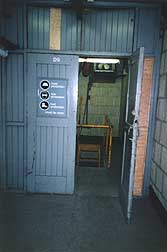 While the whole area is filled with explorable alcoves and storage rooms, there are two specific spots down here to seek out. The first is the area at the northeastern corner of the garages, which has entrances to the station's very interesting shops and mechanical rooms, including an engine room, an elevator room, a metal shop, a truck repair shop and a carpenter's shop. Providing that no employees are on duty, there is lots of stuff to peek at here.
While the whole area is filled with explorable alcoves and storage rooms, there are two specific spots down here to seek out. The first is the area at the northeastern corner of the garages, which has entrances to the station's very interesting shops and mechanical rooms, including an engine room, an elevator room, a metal shop, a truck repair shop and a carpenter's shop. Providing that no employees are on duty, there is lots of stuff to peek at here.
The second is the entrance to the steam tunnels, which is quite easy to find if you just stare at the ceiling and follow the pipes. Or look for room D9 – the D stands for delivery level, I think. In a nondescript alcove, tucked behind a pair of wooden doors, is a steep metal staircase leading further underground.
Steam Tunnels
Although Union Station is just a single building in a single location, its network of steam tunnels and mechanical rooms is quite extensive. The steam tunnels actually extend far beyond the perimeter of the station, and contain facilities for heating, ventilation and sewage disposal.
The first section Victor and I toured in detail is the area at the eastern end of the tunnels. This area is abundantly decorated with signs reading "Authorized Personel Only", but we figured no judge would convict us for ignoring such a poorly-spelled sign. The area was pleasantly devoid of any authorized personnel, though a supervisor's desk looked to have been recently occupied, some of the towels the workers had hung up on wires beside the shower stall were still drying, and there was some fairly new-looking garbage in some of the bins. We had to travel quite a way up the tunnels, and around several corners, before we came upon the more remote areas that looked like they hadn't been visited in months or years.
 Travelling south down the middle tunnels, the first room we stumbled upon had a tiny little door that proclaimed that it should remain shut. Neither Victor nor I could figure out how to get through the door without opening it, however, so we opened it just a little and just temporarily, and entered a machine room. Inside the machine room, we found a set of steep metal stairs leading one flight up to an unlocked door looking out on some marble hallways. We didn't take this route at the time, but I have since stumbled upon this same door from the other side and determined that the marble hallways are part of the lower levels of the TTR offices. Through this handy emergency exit, one can quickly exit the steam tunnels and head out to the VIA concourse or up to the TTR offices.
Travelling south down the middle tunnels, the first room we stumbled upon had a tiny little door that proclaimed that it should remain shut. Neither Victor nor I could figure out how to get through the door without opening it, however, so we opened it just a little and just temporarily, and entered a machine room. Inside the machine room, we found a set of steep metal stairs leading one flight up to an unlocked door looking out on some marble hallways. We didn't take this route at the time, but I have since stumbled upon this same door from the other side and determined that the marble hallways are part of the lower levels of the TTR offices. Through this handy emergency exit, one can quickly exit the steam tunnels and head out to the VIA concourse or up to the TTR offices.
Exiting and shutting the door behind us, we proceeded up the steam tunnels, occasionally stopping to marvel at such delights as hallways leading nowhere, stairways leading up to crawlspaces, gigantic machinery of unknown function and valves with such impressive responsibilities as "Front Street Water Supply".
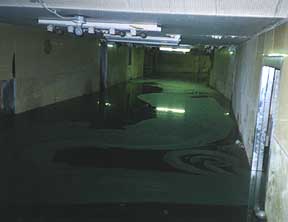 At the end of this series of tunnels, we found a cement stairway leading up to a three-foot-tall wooden door held shut by two iron bars. Carefully withdrawing these bars and setting them aside, Victor and I emerged onto a gangplank near the top of a stairway and a disassembled escalator. We wandered down the stairs, leaving footprints in the dust. At the base of the stairs, a dark, decrepit hallway with a very shiny black floor stretched out before us. Victor pointed out that the floor was all wet. "Yeah, weird," I agreed, as I put my foot down on what I expected to be a solid floor and my leg plunged through the murky black water up to my knee. After I withdrew my soaked foot from the water and wringed my socks out, Victor and I concluded that (a) I was an idiot and (b) we wouldn't be exploring that tunnel without a dinghy.
At the end of this series of tunnels, we found a cement stairway leading up to a three-foot-tall wooden door held shut by two iron bars. Carefully withdrawing these bars and setting them aside, Victor and I emerged onto a gangplank near the top of a stairway and a disassembled escalator. We wandered down the stairs, leaving footprints in the dust. At the base of the stairs, a dark, decrepit hallway with a very shiny black floor stretched out before us. Victor pointed out that the floor was all wet. "Yeah, weird," I agreed, as I put my foot down on what I expected to be a solid floor and my leg plunged through the murky black water up to my knee. After I withdrew my soaked foot from the water and wringed my socks out, Victor and I concluded that (a) I was an idiot and (b) we wouldn't be exploring that tunnel without a dinghy.
When we came back a few weeks later to take pictures, however, we found that our flooded tunnel had somehow been drained. The floor was still slimy and the place was still unlit, but we hauled out our flashlights and went to take a look. After a short way, the tunnel turned 90 degrees to the right, and then continued on an upward slant for some distance. At the end of the hallway, a set of cement stairs led up to a door. Checking this door, we found it led directly out into fare-paid area of the subway station! I won't even attempt to map this madness or guess what purpose this connection once served, but it's nice.
On our next expedition into the steam tunnels, Victor and I checked out the western set of tunnels, the largest and most interesting of the three sets of tunnels. Large steam pipes occupy at least half the width of the tunnels in most areas, so this section is also very hot and cramped. We had to remove our coats in order to endure the trek to the end of the main tunnel. At the end of the tunnel, we explored various metal staircases leading up and down, being careful not to accidentally touch the burning hot metal handrails on the staircases. One steep metal staircase led up to an interesting-looking staff area that seemed a little too recently visited for our comfort. Another metal staircase led up to a wooden door, on the other side of which another tunnel stretched off to the south. This tunnel was constructed out of cinder blocks, and seemed newer and cooler than the tunnels we'd left. After five minutes or so, we came to a room at the end of the tunnel, which contained a few uninteresting machines and a ladder leading to a street-level exit hatch. Peering out of this exit hatch, and inhaling some much-needed cool air, we determined that this exit led out to Bremner Blvd., far to the southwest of Union.
We weren't quite ready to call it a day, so we traced our steps back to the main tunnels and took a sorth-leading tunnel that we had ignored earlier. It was another one of those exceedingly hot tunnels, so we weren't exactly overjoyed when we came to a 5m-tall sheer face and had to ascend a (hot!) metal ladder to continue down the tunnel. After this we descended some stairs and continued down the tunnel for a long way, before the tunnel seemed to come to an end at a cement wall with an inconspicuous metal panel, not much wider than a locker door, set into it. We basically assumed this was the end of the road, but I decided to try and take a quick peek behind the locker door before we headed back.
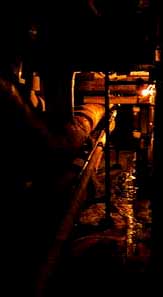 Mechanical Wonderland
Mechanical Wonderland
The inconspicuous little metal panel opened to reveal a further series of tunnels, rougher, wetter and more cramped than the main steam tunnels, which sloped down as we headed north. As well as the wet floor, occasional ladders leading up to street-level manholes give this area a drain-like quality.
Eventually, the drain-like tunnels emptied out into a low-ceilinged crawlspace area. Unpleasant odours and an abundance of rat traps kept Victor and I from exploring all the dark tunnels branching off from this area. Instead we headed up a flight of stairs and emerged into an extremely large, high-ceilinged and unpopulated room filled with machinery, oddities and wonders. This, I realized, was Union Station's famous power substation.
After the apocalypse, the smart money is on Union Station. There are self-contained carpentry, plumbing, electrical, machine and paint shops, and all sorts of tunnels and fun places to climb and play. On top of supplying the water and steam needs of itself and many of its large neighbours, Union's power substation is also capable of supplying the electricity needs of a good-sized town.
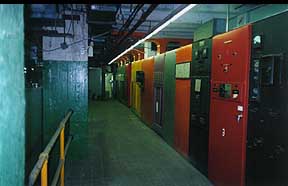 The first thing that struck me about the area was how cheerful it was, for an overgrown mechanical room. All the metal rails were painted bright yellow or bright green. A huge bank of machines was brightly decorated in all the colours of the rainbow. Yes, even indigo! For some reason, "machinist" and "interior decorator" are two items that rarely appear on the same resume, so this room was a strange sight.
The first thing that struck me about the area was how cheerful it was, for an overgrown mechanical room. All the metal rails were painted bright yellow or bright green. A huge bank of machines was brightly decorated in all the colours of the rainbow. Yes, even indigo! For some reason, "machinist" and "interior decorator" are two items that rarely appear on the same resume, so this room was a strange sight.
Other tourist attractions in this area include the huge hole in one of the cement walls leading to a chamber underneath a street grate, a collection of several dozen small wooden chairs of the type used by kindergarten children, several smaller, more abandoned-looking rooms full of lifeless machinery, and a door leading into a large unlit area connected to the station's ventilation system. This gigantic ventilation area (behind the rainbow machines) offers all sorts of fun shafts to climb in, over, around and through, and is one of the station's biggest highlights. I wish some of my pictures had turned out. Make sure to bring a flashlight along, as the area has no lights whatsoever, and bring a stack of moist towellettes with which to clean yourself afterwards.
We also discovered the hallway through which the employees enter the plant. Victor and I took the steam tunnel exit, though, because we were much too far from anywhere even vaguely public to have an excuse if we were caught.
The Great Hall
Leaving the basements and the concourse level, one comes to Union Station's most distinctive feature: the Great Hall. The Great Hall is 77m (250 feet) long and 26m (84 feet) wide, with an arched ceiling which is 26m (84 feet) tall at its centre. It is a true arch of vitrified Gustavino tile (the crowd-pleasing tile). Four-storey-tall arched windows are situated at either end of the hall. As mentioned, it is really pretty.
The Great Hall also features galleries. Two small corridors, one two storeys high and one three storeys high, run around the perimeter of the hall. These corridors are always empty and appear inaccessible to the general public. After checking nearly every door and vent in the Great Hall and finding everything quite secure, I had pretty much given up hope of ever finding my way to the upper levels of the Great Hall. Then one day, as Victor and I were idly exploring the upper levels, a businessman emerged into the hall through a glass door that had always been locked. Without thinking or even saying a word to Victor, I skipped over to the door, grabbed it before it shut, and strolled into the area beyond.
TTR Offices
As mentioned, Union Station and the tracks leading to it are operated by the Toronto Terminals Railway Company (TTR). The TTR offices are located right beside Harvey's in the Great Hall. The glass doors to the offices are usually electromagnetically locked, at least after business hours. Like other security doors in Union Station, a green LED on the lock means stop (locked) and a red LED means go (open).
Having lucked our way inside, Victor and I climbed the marble staircase up to the second floor. After looking around for a few moments, we crossed over a hallway with glass walls, a glass ceiling and a glass floor, and found our way out to the second-storey gallery looking down on the Great Hall. After taking some pictures here, we journeyed up to the third-storey gallery and had an even better view, though we had to walk past the gaze of a security camera to get there. We seemed to be the only people in the area, so we knew we'd stand out if security guards were patrolling.
Still, another flight of stairs beckoned, so we climbed up to the fourth and final floor accessible by the marble staircase. After a little looking around, though, we found a smaller, totally unlit staircase leading further up. By the light of our flashlights, we made our way up. The door to the fifth floor was locked. The door to the sixth floor lead to a records room, filled with all sorts of ancient records, but nothing very useful to us.
The door to the seventh floor opened out into a very large, high-ceilinged attic. The attic was fashioned out of red brick and iron support beams along the ceiling. There were several holes smashed through the walls leading to various pipes and ventilation systems that had presumably needed repair once upon a time. A wooden door halfway up one of the walls, with no stairs or ladders leading to it, indicated to me that the attic hadn't always existed in its present form. At the far end of the attic Victor and I found an elevator that only had a down button, and a narrow black door leading out to a stairwell with black walls that seemed to offer more possibilities.
We emerged into the dingy black stairwell, which appeared very unused. We were at the top of the stairs, but a black metal ladder led up through a hole in the ceiling and beyond. We eagerly climbed up the extremely dusty ladder and (when we again turned on our flashlights) found ourselves in a small elevator room. We could see the elevator several floors below us through the metal mesh floor. A tiny door in the wall begged for our attention. I opened it and was delighted to see a lovely view of Toronto's harbourfront at night. I peered out through the door and lowered myself down onto the green copper roof of the station, which had no guardrail around the edges, and seemed much taller than it actually was because there were no other buildings nearby. As I explored and took pictures, I shivered intensely in reaction to both the freezing cold winds and the excitement.
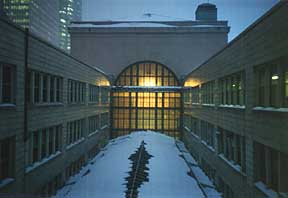 Before long I climbed back inside, and Victor and I took the black staircase back down, peering in on some interesting empty rooms as we made our way back down. When we exited the black staircase on the fourth floor, the door locked behind us. We made our way out of the TTR area by elevator.
Before long I climbed back inside, and Victor and I took the black staircase back down, peering in on some interesting empty rooms as we made our way back down. When we exited the black staircase on the fourth floor, the door locked behind us. We made our way out of the TTR area by elevator.
I headed back to the TTR offices alone one day to take some pictures and do some more exploring. After I had waited like a vulture outside the locked door to the offices for about 10 minutes, an employee finally emerged, and I prepared to accept the open door from him.
"Can I help you?" he asked, clearly employing the phrase in its 'can-I-hinder-you' sense.
"I'm supposed to be meeting someone on the fourth floor."
"How do I know you're supposed to be in here? I mean, you don't look bad or anything..."
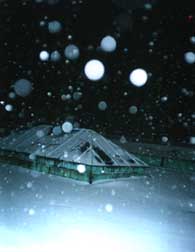 I laughed and said, "Thank you, you neither."
I laughed and said, "Thank you, you neither."
He smiled, weakening. "Okay, go ahead."
Having paid my admission fee through acting, I climbed up to the fourth floor to look for alternate paths out to the roof. I found many sights Victor and I had previously missed, including the headquarters of the CN police, an extremely ancient elevator serving the lower five levels of the TTR area, a washroom filled with 10 locked stalls labelled "this stall not in use," and another disused staircase leading to the upper levels, at the easternmost point of the fourth floor. It had been so long since anyone used this staircase that I left a five-millimeter-thick footprint in the dust everywhere I stepped. Between the fifth and sixth floors, I found an unlocked, unscreened window that led out to a lower-level roof, and stepped out to take a picture of the falling snow. At the top of the stairwell, I found a door with an extremely intimidating sign.
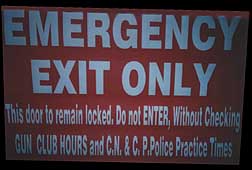
The door was locked.
For my next trick, I made my way down to the basement level of the TTR offices. A couple of TTR employees were standing in a stairwell necking when I arrived, but they seemed content to ignore me. I found a rather insecure phone closet. I tried a few doors leading down to the steam tunnels but to my immense frustration they were locked. I exited out to the VIA Concourse through a door that locked behind me. Temporarily, anyhow.
A version of this article originally appeared in Infiltration 12, together with letters and articles on the Chicago Tunnel Company tunnels, Michigan Central Station and the Buffalo Central Terminal.
|

